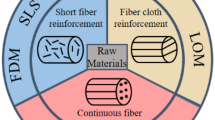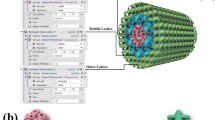Abstract
The effect of tensile prestrain on the stage I tensile yield stress has been studied both analytically and experimentally for composites whose stress-strain curves obey the rule of mixtures. The mathematical analysis provides a means for calculating the optimum amount of prestrain, the residual stresses (in the direction of the fibers) in the matrix and fiber materials after unloading from the prestraining, and the stage I yield stress in the composite after the prestrain treatment. It is shown that the improvement in stage I yield stress by prestraining is due to the development of negative residual stresses in the matrix. The stage I yield stress in composites with negligible residual stresses in the as-fabricated condition can usually be improved by a factor of two by prestraining; the amount of improvement is even greater if the as-fabricated composites have the usual state of residual stress,i.e., tension in the matrix. Experimental studies on 2024 aluminum-tungsten composites (filament-wound; hot-pressed) having tungsten fiber volume fractions between 0.08 and 0.40 verified the mathematical analysis. The stage I yield stresses measured in these composites after a prestrain of 4.2 × 10−3 were in good agreement with predicted values. Improvements of up to a factor of six were found in the stage I yield stress as a result of prestraining.
Similar content being viewed by others
References
E. Scala:Fiber Composite Materials, p. 131, ASM, 1965.
J. R. Hancock, and J. C. Grosskreutz:Metal Matrix Composites, Amer. Soc. Test. Mater., Special Tech. Publ. 438,1968, p. 134.
E. M. Lenoe:Metal Matrix Composites, Amer. Soc. Test. Mater., Special Tech. Publ. 438, 1968, p. 150.
L. J. Ebert,C. H. Hamilton, and S. S. Hecker: AFML-TR-68-71, March, 1968.
E. V. Sumner: Tenth National SAMPE Symposium, Nov. 1966, F-11.
A. A. Baker and D. Cratchley:Appl. Mat. Res., 1966, vol. 5, p. 92.
H. P. Cheskis and R. W. Heckel:Met. Trans., 1970, vol. 1, p. 1931.
H. P. Cheskis, A. Hattangadi, and R. W. Heckel: Proc. of the Fourteenth Re- fractory Composites Working Group Meeting, WPAFB, May 1969, p. 189.
H. P. Cheskis and R. W. Heckel:Metal Matrix Composites (Symposium of TMS-AIME), DMIC Memorandum 243, May, 1969, p. 58.
Author information
Authors and Affiliations
Rights and permissions
About this article
Cite this article
Heckel, R.W., Zaehring, R.J. & Cheskis, H.P. Optimization of the range of elastic behavior of unidirectional composites by prestraining. Metall Trans 3, 2507–2513 (1972). https://doi.org/10.1007/BF02647056
Received:
Issue Date:
DOI: https://doi.org/10.1007/BF02647056




